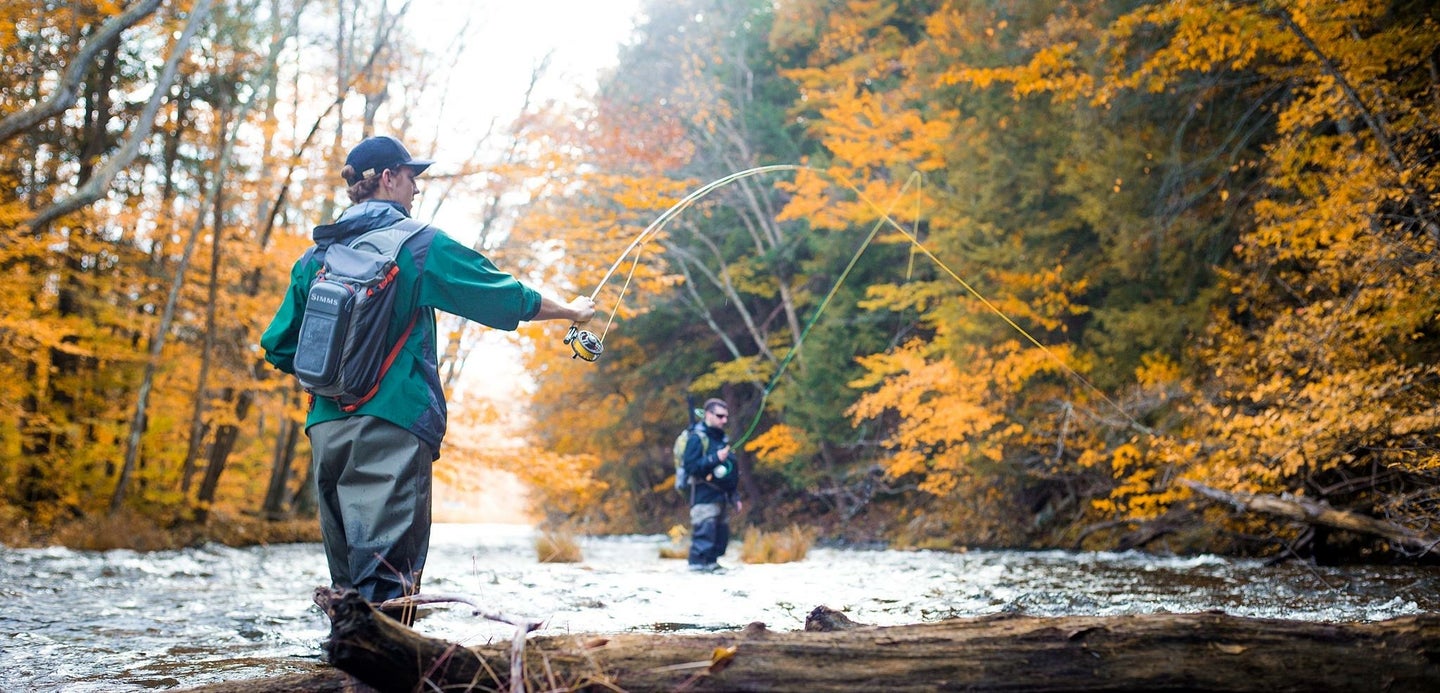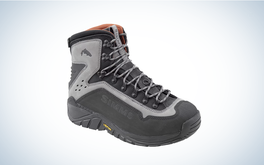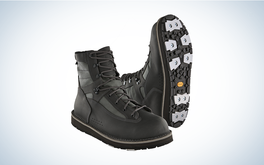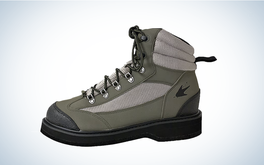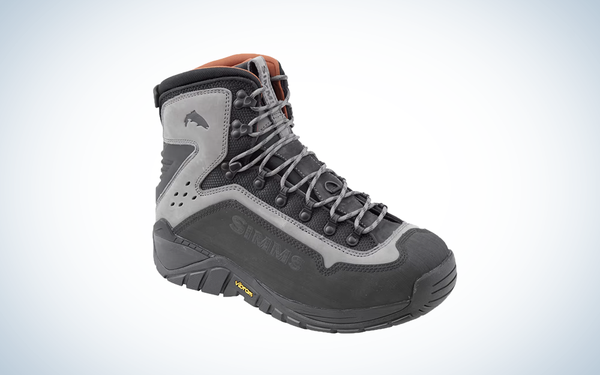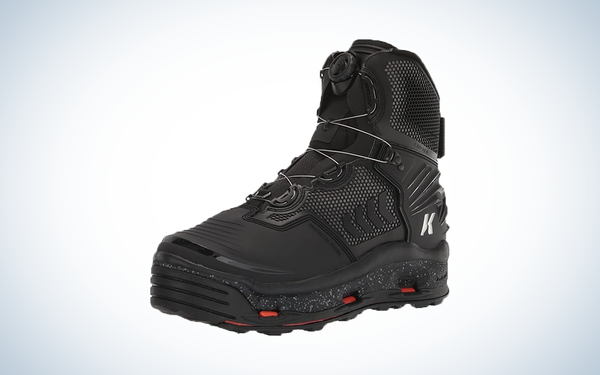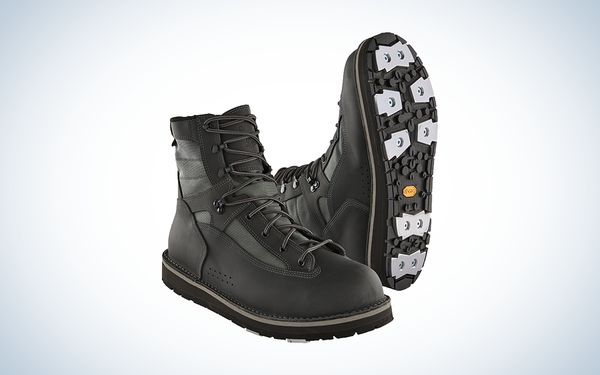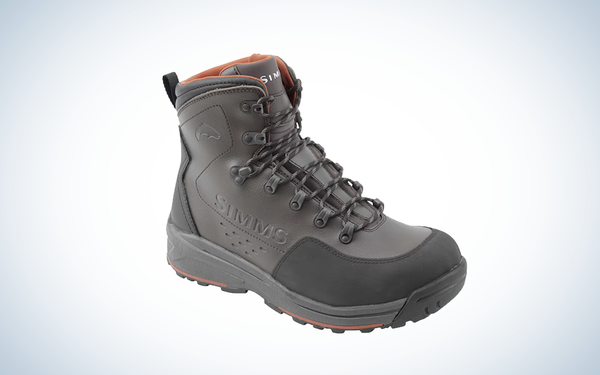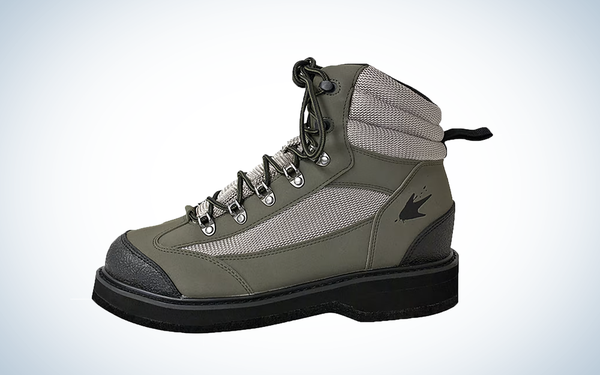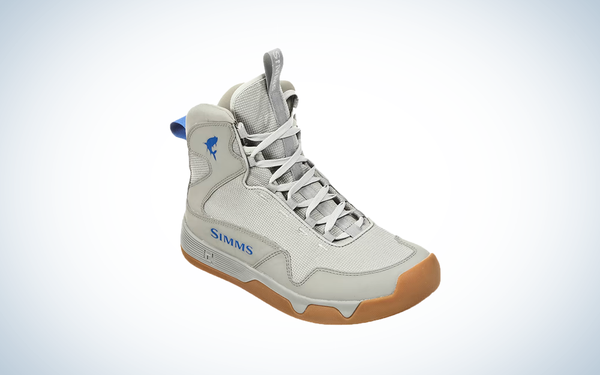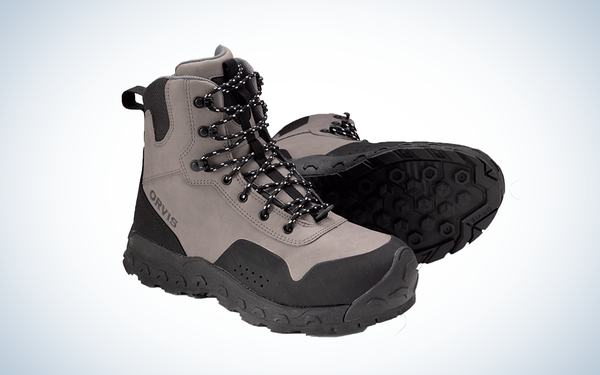We may earn revenue from the products available on this page and participate in affiliate programs. Learn more ›
My first pair of wading boots lasted me over five years. When I hung them up for good, the reglued soles were falling off again. But I was a broke college grad who thought money could be better spent on more “practical” things like fly rods and fancy fishing apparel. I was wrong. Wading boots are one of the most essential pieces of gear fly anglers will own, and every fisherman should invest in a quality pair.
There’s more that goes into choosing wading boots than just finding the right size. You must consider weight, materials, traction, sole type, and lacing. Plus, the boots should be comfortable and durable enough to last season after season. Of course, personal preference also factors in. Some anglers prefer studded rubber soles over felt soles, and others prefer laces over BOAs. But no matter what features the boots have, they still have a job to do: Keep you sure-footed and safe while wading.
I’ve spent the last seven years wearing several different wading boots in various conditions and locations across the country. This includes hundreds of miles that resulted in worn-out soles, brutal falls, broken laces, and tired feet. But this extensive trial and error process led me to find the safest and most comfortable pairs. Here are the best wading boots for every fishing scenario you will encounter.
- Best Overall: Simms G3 Mens Wading Boot
- Best with BOA Laces: Korkers River Ops Boa Wading Boots
- Best for Wide Feet: Patagonia x Danner Foot Tractor Wading Boots
- Best Value: Simms Freestone Wading Boots
- Best Budget: Frogg Toggs Hellbender Wading Boots
- Best For Saltwater: Simms Flats Sneakers Wading Shoes
- Orvis Clearwater Wading Boots
How We Picked the Best Wading Boots
In 2017, I became a river patrolman at the Douglaston Salmon Run in Pulaski, New York. The job required me to patrol the river and enforce state fishing rules and regulations, primarily by foot. I learned that eight hours on your feet all day isn’t only taxing on your body, but also on your gear, especially wading boots. This is where my testing began.
When I wasn’t working, I was fishing. The miles on the river piled up until my boots gave out. Then it was onto the next pair and the next and the next. I put hundreds of miles on many of the boots recommended below, and some I used until the soles fell off. The testing grounds ranged from the Allagash River in Maine to spring creeks in Montana to 13,000 feet above sea level in Colorado. And, of course, endless days spent chasing steelhead on the Salmon River in New York.
I’ve worn these boots in single-digit temperatures up to wading in 90-degree sweltering summer days. They have broken ice shelves, climbed rock banks, flown out of truck beds, been run over, and used until my feet were coming through them.
I also called in new models of boots from top fly fishing brands and took them on the river in my home state of Colorado to test. Regardless of whether the boots were new or old, I evaluated them on a few key aspects:
- Fit and comfort: How well do the boots fit my feet? Are they comfortable to wear all day? Can you wear them five days straight and not be sore?
- Durability and lifespan: Can the boots withstand the rough conditions of a rocky river? How do they hold up in the cold as well as the heat?
- Support and protection: Do the boots support your foot and your ankle? Will they protect you against rocks, ice, and hard bottoms?
- Soles and traction: What type of sole does the boot have? Is it compatible with studs? How well do the studs hold in the boots? Do you feel like you have your footing in a slippery river?
- Value and warranty: Does the price reflect the product? Do the boots come with a warranty?

Best Wading Boots: Reviews & Recommendations
Best Overall: Simms G3 Mens Wading Boot
Specs
- Sizes: 7-14
- Soles: Vibram or felt
- Laces: Traditional
Pros
- Comfortable and durable
- Great ankle support
- Rubber outsoles hold studs well
Cons
- Leather shrinks after use but expands when back in water
The Simms G3 Guide Boots have been my go-to for the last couple of years. They are comfortable, supportive, and durable enough to last multiple seasons without issue. I like the traditional laces, which lock into place before securing the tongue of the boot. I’ve put over 100 days on the water in these boots and have yet to have any major issues with them.
My G3s have Vibram rubber soles which I screw studs into for better stability on the river. But you can also get them with a felt sole if you prefer that style. If you go with the Vibram, I highly recommend some sort of studs, whether it’s the Simms studs or these more affordable motorcycle racing studs, which come in a 250-pack for $30 and are easy to screw in with a drill.
The build quality of this boot is what makes it a premium piece of gear. The outsole is extremely durable and the toe is rock solid to prevent injury from any impact. Dual-density midsoles make the G3s comfortable for all-day wear—my feet have never felt sore, even on long trips.
My only complaint is that the nubuck leather will shrink when the boot dries out. This makes it a little more difficult to put on, but once the boot is back in the water, it will regain its original shape.
Best with BOA Laces: Korkers River Ops Boa Wading Boots
Specs
- Sizes: 8-15
- Soles: Felt, Vibram, or Vibram with studded soles
- Laces: BOA
Pros
- Interchangeable soles (felt, Vibram, studded Vibram)
- Easy to put on BOA laces
- Lightweight
Cons
- The sole latch may rip over time
- BOA can break after a lot of use
I was never a Korkers guy, until this summer. The River OPS is Korkers premium wading boot, and I wore it this entire past trout season. It features a BOA lacing system that allows a secure fit and interchangeable outsoles. Anglers have the option of choosing either felt outsoles and XS Vibram outsoles or XS Vibram outsoles and studded Vibram outsoles. I opted for the latter and almost exclusively wore the studded soles for increased stability.
The River OPS is as comfortable as any wading boot I’ve worn. It has a reinforced EVA midsole and a lightweight abrasion-resistant design that makes walking across rocks and slippery boulders more than doable. I was impressed by how comfortable my feet were after multiple five-day trips.
Switching out the outsoles takes no longer than 30 seconds on each boot. They snap into place, and a rubber latch locks into the back of the boot. I’ve had no issues with it so far, but I have heard other anglers complain about the rubber latch breaking over time. While some fishermen prefer felt outsoles, I recommend getting Vibram ones and adding studs or attaching the included studded outsole.

Best for Wide Feet: Patagonia x Danner Foot Tractor Wading Boots
Specs
- Sizes: 5-14
- Soles: Vibram or felt
- Laces: Traditional
Pros
- Great traction
- Easy to put on
- Offers solid protection and durability
Cons
- Heavy
- Expensive
Patagonia teamed up with the folks at Danner to make one of the most unique pairs of fishing boots on the market—the Foot Tractor wading boots. Now, I know what you’re thinking: How could a flat aluminum bar provide any sort of grip on a slippery river? I thought the same thing until I started fishing in these boots. The aluminum bars provide a surprising amount of traction in the slickest of waters. I fished in the Foot Tractors all through the winter and never took a bad fall. They offer a rock-solid grip—just as good or even better than any other boot I’ve worn.
The upper is made of two different materials: waterproof leather and 1000 denier nylon. Both of these materials are extremely rugged and absorb little water. The heel counter and toe box are also very durable and offer maximum protection. The boots are easy to get on and include speed lacing for quick adjustment.
The aluminum bars on the outsoles come with the downside of being very heavy. In fact, these are the heaviest wading boots I’ve ever worn. Now, that’s expected with the bars, but you’re sacrificing weight for traction. The Foot Tractors are also offered in a sticky rubber Vibram outsole and felt outsole. This is also one of the more expensive wading boots, but they are comfortable, durable, and will last year after year.
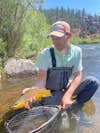
Best Value: Simms Freestone Wading Boots
Specs
- Sizes: 7-14
- Soles: Vibram or felt
- Laces: Traditional
Pros
- Lightweight
- Affordable
- Very comfortable
Cons
- Soles will wear out faster than premium boots
I have yet to put as many miles on one particular pair of boots as I did on my old Simms Freestones. I’ve walked hundreds of miles in these boots, and they never let me down. I put them through the ultimate torture test—rain, ice, sand, heat, rocks, cliffs, and any other imaginable weather condition. They came out on top every single time.
The Freestones are one of Simms middle-of-the-pack wading boots, and they offer the biggest bang for your buck. They are made from a synthetic leather upper with protective scratch panels on the heels and toes. The neoprene linings and EVA midsoles make for one of the most comfortable wading boots I’ve ever worn, especially when broken in. These were not only my fishing boots, but also my work boots when I was a river patrolman on the Salmon River. Which meant I was on the water four to five days a week, wading hundreds of miles. And I always felt comfortable in my Freestones.
I opted for the rubber outsoles and motorcycle studs (because I didn’t want to pay for expensive ones) that provided more than enough traction. After five years in these boots and a couple of reglued soles, I finally retired them. I’ve since switched to “premium” wading boots, but I’m still not convinced they are better than the Freestones. I think about going back to Simms Freestones every season, and they are the boots I recommend to any new angler.
Best Budget: Frogg Toggs Hellbender Wading Boots
Specs
- Sizes: 7-14
- Soles: Vibram or felt
- Laces: Traditional
Pros
- Lightweight
- Very affordable
- Comfortable
Cons
- Not the best build quality
Expectations are not high for a pair of wading boots that just break the c-note mark, but the Hellbenders are an impressive budget boot. You can get them with either rubber Vibram or felt outsoles for the same price, which is often on sale for under $100. I wore my Vibram pair of Hellbenders on a few trips this summer and was pleasantly surprised.
They are comfortable, lightweight, and durable enough for moderate wading conditions. These boots are ideal for beginner anglers or those who only spend a few weeks a year on the river. The construction is a bit below higher-end boots, and I wouldn’t recommend wearing these if you spend 100-plus days on the river each year. But for the casual angler and beginner, the Hellbenders are a great option.

Best For Saltwater: Simms Flats Sneakers Wading Shoes
Specs
- Sizes: 7-14
- Soles: Gum rubber
- Laces: Traditional
Pros
- Lightweight
- Comfortable
- Shoe-like feel
- Durable for tough saltwater conditions
Cons
- One-dimensional for saltwater flats
The harsh and corrosive elements of saltwater call for a different style of wading boot, and the Simms Flats Sneaker is ideal for clear sandy saltwater flats. They are built like athletic sneakers, and that’s exactly what they feel like. They have a mid-cut design with synthetic uppers that are built to withstand corrosive saltwater. The inside of the boot is made with a comfortable foam lining, and it is lightweight enough to wear for all-day fishing.
The outsole is a gum rubber construction that offers great stability for sand, coral, and rocks on saltwater flats. It is important to note these boots are not made to fish rocky shorelines that require dangerous technical wading. These are fly fishing boots made for anglers pursuing bonefish, permit, tarpon, and any other fish you may find up in shallow clearwater flats.

Orvis Clearwater Wading Boots
Specs
- Sizes: 7-15
- Soles: Vibram or felt
- Laces: Traditional
Pros
- Inexpensive
- Durable construction
- Rubber soles provide solid traction on slippery surfaces
- Lightweight
- Comfortable
Cons
- Somewhat rigid
- Not well-suited for long periods of hiking outside the water
I’ve been putting these boots through the wringer on Montana’s Bitterroot River—as well as the West Fork of the Bitterroot—for the last three months. I’ve found that they’re sturdy and stable even in swift, slippery conditions. Their heavy-duty rubber soles performed particularly well during spring runoff on the West Fork—when dam release and snow melt had the small river raging in certain spots.
While fishing in early summer, the soles let me hold tight to uneven rocks as native cutthroats were rising to salmon flies and golden stones. I was able to wade the river with relative ease in places where the water was low. The only drawback to these boots was a mild amount of discomfort in the higher part of the ankle guard when hiking more than a mile or so along the bank in order to bypass swift, unwadable rapids. If you’re looking for an affordable, reliable boot for traditional wading, the rubber-soled Clearwater from Orvis is a no-brainer. —Travis Hall

What to Consider When Choosing Wading Boots
Finding the right pair of wading boots isn’t just about size and fit. There are other important facts like pursuit, environment, traction, how much you fish, what you need your boot to do, and comfort.
Pursuit
First, be realistic about how many days you spend on the water. This will determine if you need a premium boot made from high-end materials or if you can get away with a budget pair for the few trips you do a year.
Outsole
Next, think about what outsole you prefer—felt or rubber. I like Vibram rubber outsoles with studs. And you don’t need to buy the $50 puck of studs from a fancy fishing brand. These motorcycle studs have done the job for me for the last five years. I screw as many as I can into the bottom of my boots.
Laces
Wading boots nowadays usually come with traditional laces or BOA laces. I’ve fished with both and prefer traditional laces because BOAs are known to break over time and in cold weather. Plus, it can be a pain to replace them. Make sure you also look for boots with a comfortable midsole and a good heel counter and toe box.
Sizing
Sizing can be tricky for wading boots. I wear an 11.5 shoe size and a size 12 for wading boots. This is true across any brand for me, and I recommend at least going a half size up for wading boots. But you might have to go a full size up because most companies don’t make half sizes.
FAQs
Q: How do I keep my wader boots from slipping?
The best way to keep from slipping on the river is to add studs to your wading boots. Orvis and Simms both sell quality studs, but I prefer these motorcycle studs that come in bulk and are easy to screw into rubber soles. Just remember to replace them when they wear down. Felt outsoles also provide traction while wading.
Q: Should you get wading boots a size bigger?
Yes, I recommend sizing up for wading boots. This holds true for any brand. I wear an 11.5 shoe size and a size 12 for wading boots.
Q: Do you need wading socks for wading boots?
You only need wading socks if you are wet wading. Otherwise, stockingfoot waders are what you wear with wading boots.
Q: Do your feet get wet in wading boots?
Only if you’re wet wading. Your feet will not get wet when you wear fishing waders and wading boots unless there is a hole in your waders.
Best Wading Boots: Final Thoughts
- Best Overall: Simms G3 Mens Wading Boot
- Best with BOA Laces: Korkers River Ops Boa Wading Boots
- Best for Wide Feet: Patagonia x Danner Foot Tractor Wading Boots
- Best Value: Simms Freestone Wading Boots
- Best Budget: Frogg Toggs Hellbender Wading Boots
- Best For Saltwater: Simms Flats Sneakers Wading Shoes
- Orvis Clearwater Wading Boots
A fly angler’s wading boots are one of, if not, the most important, piece of gear they will own. Boots play a big factor in your comfort on the river and serve as the main line of defense against slippery rocks and riverbeds. Anglers should consider investing in a quality pair that will last season after season. The Simms G3 boots and Korkers River Ops are two of the best wading boots I’ve ever worn and can take the abuse of hundreds of days on the water per season.
Why Trust Us
For more than 125 years, Field & Stream has been providing readers with honest and authentic coverage of outdoor gear. Our writers and editors eat, sleep, and breathe the outdoors, and that passion comes through in our product reviews. You can count on F&S to keep you up to date on the best new gear. And when we write about a product—whether it’s a bass lure or a backpack—we cover the good and the bad, so you know exactly what to expect before you decide to make a purchase.
